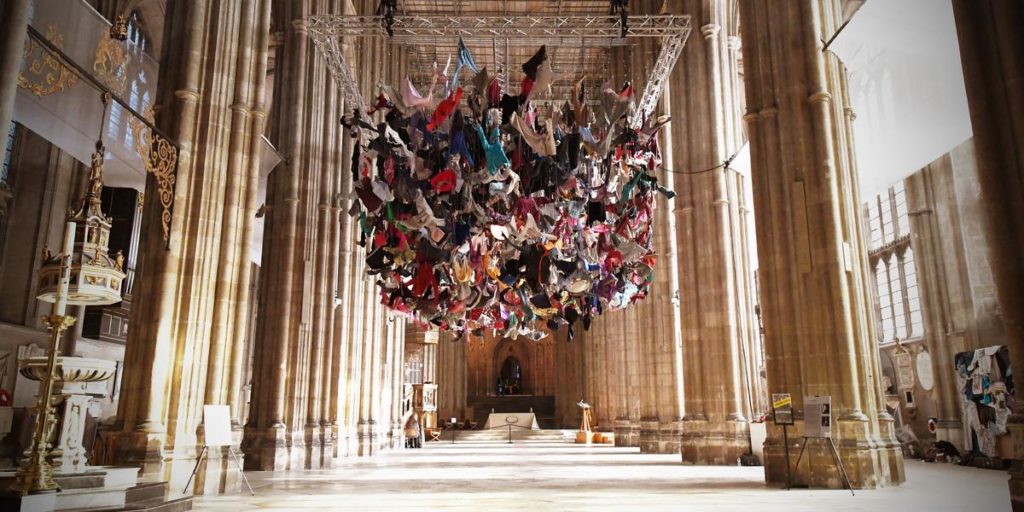A monstrous piece of artwork highlighting the plight of ‘refugees’ around the world is currently being exhibited in the Nave of Canterbury Cathedral.
During a family Easter break in Whitstable, Kent, I, my daughter and two grandchildren took the opportunity of a trip to nearby Canterbury, looking forward to re-visiting the Cathedral, which I had last seen twenty-five years previously.
We went on the Wednesday following the Easter weekend or more precisely ‘holyday,’ as this period is the most important in the Christian calendar, something that is mostly forgotten as the media pushes bunnies and chocolate eggs.
Going into the cathedral, I was expecting that sense of awe one gets on entering any of our great cathedrals, the towering pillars, stained-glass windows, the vast space and the sense of centuries of history.
Also, remembering our ancestors who built such a magnificent structure using just basic tools.
Instead, we were presented with the spectacle of, what appeared to be, a huge cluster of suspended items of clothing, like a giant rotary clothes-line, completely filling the nave and totally dominating the view of the interior, which I guess was the intention.
I knew almost instinctively, from prolonged exposure to such diversity propaganda, that it almost definitely would be something to do with ‘refugees fleeing for their lives,’ and surprise, surprise—it was.
This description is taken from the Canterbury Cathedral website:-
‘An evocative artwork highlighting the plight of refugees around the world is to be hung in the Nave of Canterbury Cathedral.
Suspended (by the British artist Arabella Dorman) is made up of hundreds of items of refugee clothing, found mainly on the beaches of the Greek island of Lesbos and kindly donated by the Starfish Foundation and the Dirty Girls of Lesvos charities (both refugee charities based in Lesbos).
The clothing appears to hover approximately three metres above the ground, and the installation is lit from the centre so that the clothes are seen clearly and then lost in shadow.
As the installation brightens, it represents the light of hope by which a refugee is carried forwards.
As it dims, it seeks to remind the viewer that refugees may be left unseen and in darkness if their situation is forgotten.
Included amongst the clothes hung in Canterbury are those left behind in the makeshift camps set up in Calais.
What Arabella Dorman seems to forget is that the overwhelming majority of ‘refugees’ are economic migrants.
Ms Dorman said:
“My interest lies in the men, women, and children behind the headlines, the individual stories behind the politics. I attempt to illuminate and to reveal the human face of conflict, and to find light in the darkest corners of existence.”
Well, Ms Dorman, our interest lay in experiencing our magnificent Canterbury Cathedral without being bombarded with left-wing, hand-wringing propaganda.
With this eyesore dominating the central part of the Cathedral, this was just not possible.
In its effort to appease the ‘diversity’ beast, the Church of England seems keen that their churches be seen as ‘community spaces’ rather than places of worship, and to facilitate this have mostly removed the original pews, to be replaced by stackable chairs making our great churches look more like school assemblies.
Furthermore, every church will have at least one shrine worshipping the new God of Diversity.
On The Church of England’s website, people are invited to “become a tourist on your own doorstep by going to church,” portraying ‘church’ almost entirely concerning heritage and art, with no mention of anything spiritual.
And this was definitely the message I got during my visit—that I was wandering around another Visitor Centre, not following in the footsteps of centuries of Christian pilgrims.
Even Gay Pride marches are openly welcomed and ‘blessed’ by significant church leaders.
We have the spectacle of the female Dean of Salisbury Cathedral, enthusiastically bestowing God’s blessing on Salisbury Pride march while standing beside a man skimpily dressed in women’s clothing.
There was even Church of England representation at Brighton’s LGBT celebration event.
This kind of craven capitulation in the name of ‘inclusion’ may raise a smile, but it seriously diminishes the Church’s standing, while simultaneously offending its more conservative members.
As my ticket allows me multiple visits for one year, I am hoping to go back with my grandson, once the ‘Suspended’ eyesore has been removed, and hopefully not replaced by another offensive spectacle, so that he might experience the mother church of Anglicanism in all its unadorned, propaganda-free glory.
How can the Church of England expect to be relevant to anybody, let alone Christians, when it is not sure of its own identity?



